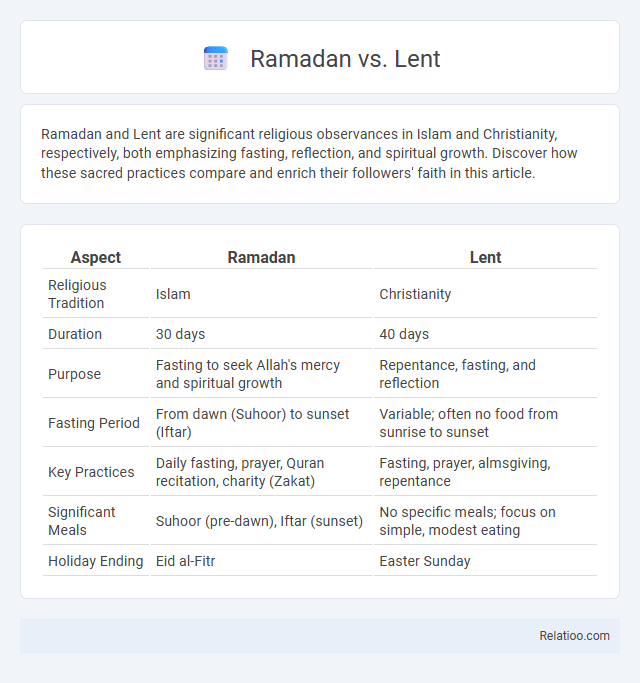Ramadan and Lent are significant religious observances in Islam and Christianity, respectively, both emphasizing fasting, reflection, and spiritual growth. Discover how these sacred practices compare and enrich their followers' faith in this article.
Table of Comparison
| Aspect | Ramadan | Lent |
|---|---|---|
| Religious Tradition | Islam | Christianity |
| Duration | 30 days | 40 days |
| Purpose | Fasting to seek Allah's mercy and spiritual growth | Repentance, fasting, and reflection |
| Fasting Period | From dawn (Suhoor) to sunset (Iftar) | Variable; often no food from sunrise to sunset |
| Key Practices | Daily fasting, prayer, Quran recitation, charity (Zakat) | Fasting, prayer, almsgiving, repentance |
| Significant Meals | Suhoor (pre-dawn), Iftar (sunset) | No specific meals; focus on simple, modest eating |
| Holiday Ending | Eid al-Fitr | Easter Sunday |
Introduction to Ramadan and Lent
Ramadan and Lent are significant religious observances in Islam and Christianity, respectively, marked by fasting, prayer, and reflection. Ramadan lasts 29-30 days, commemorating the Quran's revelation to Prophet Muhammad, emphasizing spiritual purification and self-discipline. Lent spans 40 days before Easter, representing Jesus Christ's sacrifice, focusing on repentance, penance, and preparation for resurrection celebration.
Historical Origins of Ramadan and Lent
Ramadan originated in the 7th century CE as a sacred month in Islam commemorating the Quran's revelation to Prophet Muhammad, emphasizing fasting from dawn to sunset to cultivate spiritual reflection and self-discipline. Lent traces back to early Christianity, evolving from a 40-day fasting period symbolizing Jesus Christ's 40 days of fasting in the desert, serving as a time for penance and preparation before Easter. Both observances share a symbolic focus on purification, sacrifice, and renewal, rooted in their distinct religious histories and theological meanings.
Core Beliefs and Spiritual Significance
Ramadan, Lent, and their associated symbolism center on core beliefs of self-discipline, repentance, and spiritual renewal in Islam and Christianity, respectively. Ramadan involves fasting from dawn to sunset to purify the soul and develop empathy, while Lent emphasizes sacrifice and reflection through fasting and abstinence to prepare for Easter. Your observance of these periods deepens faith through symbolic acts that represent inner purification and a commitment to spiritual growth.
Fasting Practices: Differences and Similarities
Ramadan fasting requires Muslims to abstain from food, drink, and other physical needs from dawn until sunset for 29-30 days, symbolizing spiritual reflection and self-discipline. Lent fasting in Christianity involves giving up certain foods or luxuries for 40 days, often emphasizing penance and preparation for Easter. Both practices share themes of sacrifice and purification, but Ramadan mandates total daily fasting during daylight, while Lent fasting is more flexible, often allowing limited food intake.
Rituals and Religious Observances
Ramadan, Lent, and their associated rituals symbolize profound spiritual devotion across Islam and Christianity, centering on fasting, prayer, and reflection. During Ramadan, Muslims observe a month-long daytime fast to cultivate self-discipline and empathy, culminating in nightly prayers known as Tarawih. Similarly, Lent involves fasting on specific days, abstinence, and increased prayer, symbolizing repentance and preparation for Easter, while both traditions highlight sacrifice as a pathway to spiritual renewal and connection with the divine.
Community and Family Traditions
Ramadan and Lent are sacred periods marked by fasting, prayer, and reflection, deeply embedded in Islamic and Christian traditions, respectively. These observances bring families and communities together through shared rituals such as breaking the fast during Iftar or attending church services and communal meals on Sundays. Your engagement in these traditions strengthens bonds, fosters a sense of belonging, and highlights the powerful symbolism of sacrifice, renewal, and spiritual growth within diverse cultural contexts.
Dietary Rules and Restrictions
Ramadan and Lent are religious observances that involve significant dietary restrictions symbolizing spiritual discipline and purification. During Ramadan, Muslims fast from dawn until sunset, abstaining from food, drink, smoking, and marital relations to foster self-control and empathy for the less fortunate. In contrast, Lent, observed by many Christians, typically involves giving up certain foods or indulgences, such as meat or sweets, with the aim of sacrifice and preparation for Easter, reflecting themes of penance and reflection.
Duration and Timing of Observances
Ramadan lasts for 29-30 days based on the lunar Islamic calendar, occurring during the ninth month and involves fasting from dawn to sunset. Lent spans 40 days, beginning on Ash Wednesday and ending on Holy Saturday, observed by Christians as a period of fasting and repentance before Easter. Your understanding of these observances highlights how their durations and timing are deeply tied to religious calendars and symbolic renewal periods.
Impact on Daily Life and Culture
Ramadan and Lent are significant religious observances in Islam and Christianity, respectively, each profoundly shaping daily routines through fasting, prayer, and reflection, fostering spiritual discipline and self-control. Ramadan emphasizes a month-long daytime fast, communal iftar meals, and increased charity, strongly influencing social interactions and cultural traditions in Muslim communities. Lent, observed for 40 days, encourages fasting, abstinence, and almsgiving, promoting personal sacrifice and renewal that permeates daily habits and Christian cultural practices globally.
Conclusion: Shared Values and Unique Aspects
Ramadan and Lent both emphasize fasting, reflection, and spiritual growth, underscoring shared values of self-discipline and compassion in Islam and Christianity. Ramadan's month-long fast from dawn to sunset contrasts with Lent's 40-day period of selective fasting and penance, reflecting unique religious traditions. The symbolism in each practice deepens communal faith while highlighting distinct theological foundations and cultural expressions.

Infographic: Ramadan vs Lent
 relatioo.com
relatioo.com